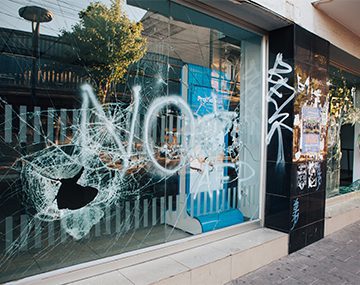By: Kevin Mershimer, Senior Sales Executive / Risk Advisory Solutions
The definition of vandalism is the willful marking upon, defacing, and damaging of property. It is a severe problem, affecting all types of businesses through its senseless destruction of property. While most of the damage is directed against public buildings and structures, private buildings suffer as well.
Patterns of vandalism indicate that vandals are attracted to isolated or remote areas (prime locations for manufacturing operations) where the damage can be done unobserved. Therefore, controlling access onto the property is an essential consideration in developing vandalism countermeasures.
This report provides information on assessing the risk of vandalism and presents general guidelines for controlling losses.
Assessment
An initial step in developing a strategy to prevent or deter vandalism is to identify the type of vandalism occurring and who the perpetrators are. Different strategies have to be implemented for each type of vandalism. The measures chosen must suit the situation.
Some questions to be asked include:
- Are there signs of vandalism on the premises, such as graffiti on building walls?
- Are there signs of transients or vagrants living on or about the property?
- Is the perimeter of the property protected by a fence?
- Are hazardous materials stored outside that may be targets of criminals?
- Is the property adequately illuminated?
- Are there security patrols of the property?
Prevention
The primary method of preventing vandalism is to design buildings that are difficult to vandalize. The physical design of buildings, such as features that allow for increased visibility of intruders, plays an important role in deterring vandalism. Inadequate lighting and places of concealment, such as dense shrubbery, isolated parking areas, and alleyways, create opportunities for vandalism. The physical design may also improve a community’s sense of shared interest in maintaining the quality of their environment, increasing the tendency of residents to act if vandalism is observed.
Grounds should be kept clear of rocks, bottles, and other objects that can be used as projectiles. Clear anti-graffiti coatings can be applied to surfaces to make them easier to clean. Exterior lighting will serve to discourage vandals; lighting fixtures should be protected through the use of plastic lenses or metal screens over the installations. Physical barriers (e.g., chain-link fencing and walls) will serve to limit access onto the property.
Outside storage of hazardous materials should be avoided. If these materials are stored in yard areas, they should be secured in a separately fenced area and, when necessary, afforded alarm protection or closed-circuit television surveillance.
Vehicles should be immobilized by disabling them or using anti-theft/anti-vandalism devices and parked centrally in a well-lighted, secure area. All vehicles and equipment should be locked during non-working hours. Oil and gas tank caps of equipment and vehicles should be locked, where possible.
Another effective vandalism prevention measure is security patrols, whether by the local police or private security services. Security patrols serve as deterrents because they increase the risk that a vandal will be caught.
References
1.Engineering and Safety Service. Vandalism: An Overview of the Problem. CP-25-10. Jersey City, NJ: ISO Services Properties, Inc., 2005.
Material posted on this website is for informational purposes only and does not constitute a legal opinion or medical advice. Contact your legal representative or medical professional for information specific to your legal or medical needs.



